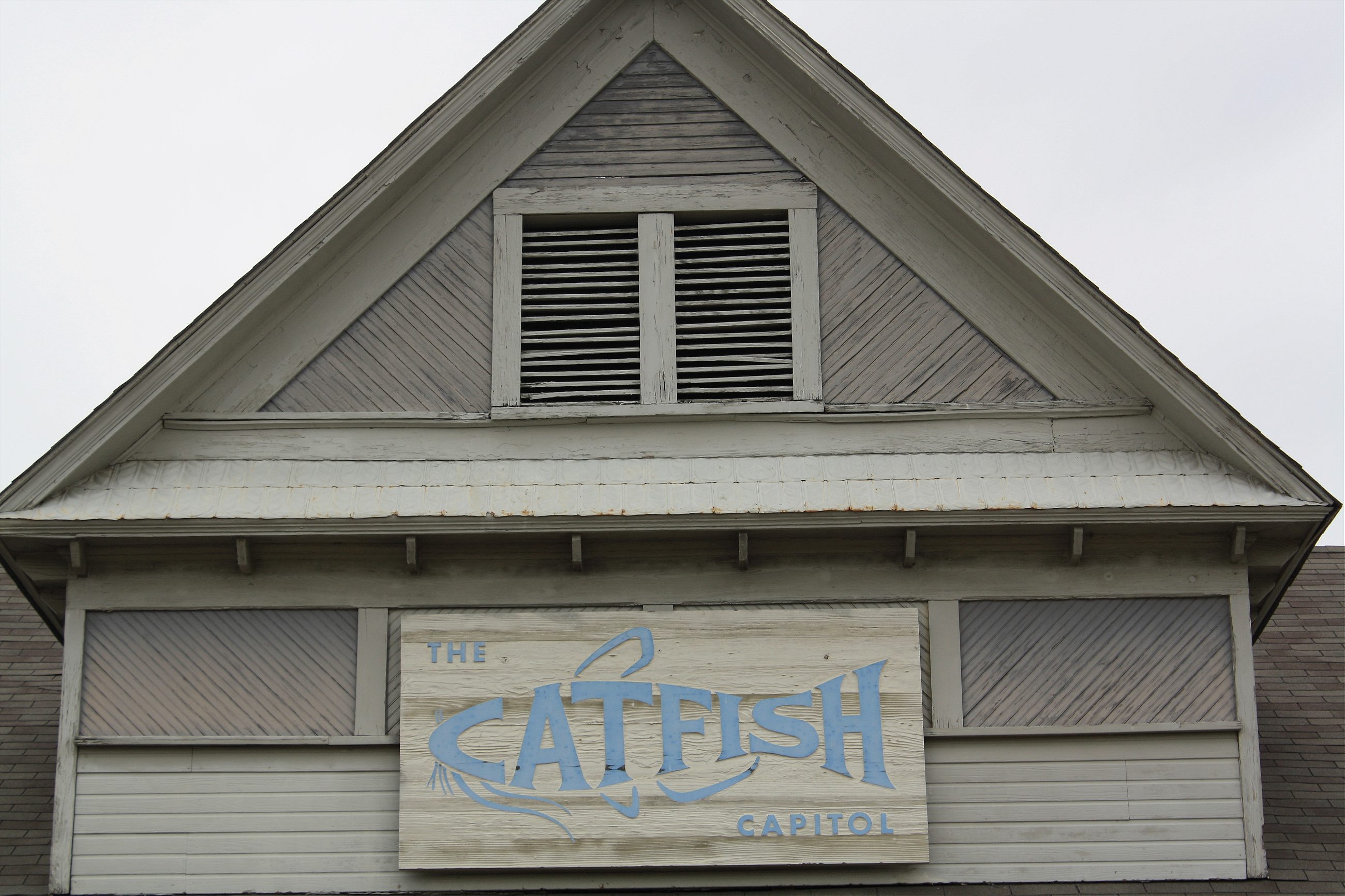In the Mississippi Delta, farmed catfish swims in a deep pond of politics, history, and big business. Boyce Upholt reports.
A hundred and seventy years ago, when white men and their slaves first arrived in the swampy forests along the Mississippi River, catfish was a low-class food. It was left for young boys or for the poorest of all races, people who lived off whatever they could forage and pulled the fish from local tributaries with cane poles.
If the World Catfish Festival is any indication, though, times have changed. At this year’s celebration, 39th, I watched Miss Catfish accept her crown beneath rippling banners with the names of corporate sponsors. The winner, a pretty local 19- year-old, had been carefully selected, as our announcer told us, to “represent the farm-raised catfish industry for the next twelve months.”
Catfish is now a proud symbol of Mississippi—a “great American story”
Catfish is now a proud symbol of Mississippi—it is healthy and sustainable, a “great American story,” as one industry lawyer put it to the Mississippi Business Journal, in a state with too many stories of struggle and decline. But outside the South, it has never quite shed its reputation as a bottom-feeder—as an omnivorous fish that eats whatever gunk settles down onto its murky riverbed.
When the new U.S. Farm Bill included concessions to the catfish farming industry, liberals and conservatives alike decried the bill’s so-called protectionism and government waste. Editorials held up the industry as an example of all that’s wrong with the politics of American farming, and accused Sen. Thad Cochran of being, of course, a “bottom feeder.”

In early April I found myself standing in a buffet line in Belzoni, Miss., alongside tourists from across the country, waiting for my own Styrofoam platter of fried fish, trying to figure out just what it means to celebrate the catfish. Almost 40 years ago, this tiny town declared itself the World Capital of Farm-Raised Catfish. That makes it the humble ground zero of one of America’s biggest agricultural disputes.
The first thing I noticed as I pulled into Belzoni was a parade of political signs staked in the grass of the highway median.
Thad Thad Thad, they repeated, because here Thad Cochran is famous enough to be recognized by first name alone. He’s the second-most senior Republican in the Senate, first elected in 1972.

Tomorrow, June 3, Cochran faces a tough primary election. The Washington Post has called it the Tea Party’s “last stand” after a series of defeats in primaries this spring. Though Chris McDaniel, the challenger, has been mired by campaign missteps, the final outcome is still far from certain, with Cochran hanging onto a slim lead.
It’s clear that Cochran’s campaign is taking no chances with the catfish crowd. Volunteers for Cochran wandered the crowd at the festival, pressing stickers labeled “Thad” onto lapels; nearly everyone I saw had a sticker. At one point I noticed a group holding a McDaniel sign, but when I looked again, they had slunk off into the crowd. This was a catfish festival, after all, and Thad Cochran is a hero to catfish farmers.

Thanks to his longevity, Cochran is the ranking member of the Senate Agriculture Committee. Roll Call reports that, in an attempt to remind the local electorate of his devotion and power, he used that position to favor Mississippi aquaculture, refusing to move forward any legislation that did not contain certain pro-industry provisions.
The gambit worked. The final law requires the U.S. Department of Agriculture to begin inspecting catfish within a year, a move for which domestic catfish farmers have long fought. It will, they hope, cut back on international imports, which are threatening the domestic industry. As recently as 2005, imports made up only 20% of the U.S. market. Now the numbers have reversed: nearly 80% of the “boneless, frozen catfish fillet products” consumed in the U.S. are from foreign sources, particularly from Vietnam.
The previous Farm Bill, passed in 2008, had similar requirements, and the USDA spent $20 million to create an inspection program, though implementation never began. In 2013, as the new Farm Bill came up for debate, the USDA estimated that inspections would cost around $14 million a year. Meanwhile, another agency, the Food and Drug Administration, was already inspecting catfish at a cost of only $750,000 annually.
John McCain said last year that he aimed to “deep-fry” the new program
That redundancy and price gap is the crux of the controversy. John McCain said last year that he aimed to “deep-fry” the new program; President Obama, when he submitted his budget proposal last April, tried to cut it, too. Even the USDA itself, though it asserts its commitment to the law, commissioned a report from the Government Accountability Office to evaluate whether the new program made sense. Released in 2012, the report suggested that since the G.A.O. believed catfish to be a low-risk food, Congress should repeal the portions of the law that required USDA inspection.
Last fall the inspections nearly caused an international trade dispute. As the U.S. attempted to negotiate an agreement with a group of Pacific nations, Vietnamese officials sent a stern letter to John Kerry and other government figures. “Our government is unwilling to sit by as this program is implemented,” they wrote. That warning rallied other U.S. farmers against the inspections, too, since Vietnam is a big consumer of U.S. beef and soybeans.
Troubling chemicals, including formaldehyde, have been found in imported fish
Proponents point out that the new bill actually removes the redundancy. One consultant I spoke with said that domestic farmers do not seek protection, just equivalency: their catfish will be subject to the same strict inspection as imports. And there are food safety groups, like Food and Water Watch, that agree that closer oversight of catfish is needed. Part of the reason that farmed catfish is lauded by groups like Seafood Watch is that it’s generally produced quite sustainably in the U.S. But troubling chemicals, including formaldehyde, have been found in imported fish. This February, due to high concentrations of antibiotics and hormones, Russia banned importation of the Vietnamese fish. The consultant told me that the FDA currently examines less than 2% of all seafood, and he worried that an outbreak, even from a foreign source, would send consumers running from all catfish.

Belzoni—which is pronounced, depending on who you ask, either Bel-ZONE-uh or Bel-ZONE-ee—is typical of the Mississippi Delta, this flat floodplain in northwestern corner of the state that is two hundred miles long and, at its thickest, sixty miles across. The town is sleepy, just over 2,000 residents; the quaint storefronts of its small downtown are mostly boarded up now.
But at the festival the streets were bustling, lined with vendors who sat under vinyl pop-up tents. There were plenty of familiar wares, the same stuff always sold at small-town Mississippi festivals: homemade pickles, Ole Miss yard signs, lawn furniture made from scrap wood.
But at the Catfish Festival there was also a preponderance of lesser tchotchkes. Whole tents were devoted to the sale of foam toys spray-painted to look like lizards, or to the kind of inflatable rubber instruments they gave away at the bar mitzvahs I attended as a kid.
Downtown Belzoni is dotted with fiberglass statues of catfish, man-sized and brightly painted. The art project, Catfish on Parade, was installed ten years ago when the catfish industry was at its peak. During the festival, when, I stopped to examine the statues, I found that most of the plaques indicating names and artists had fallen off.
This disrepair feels emblematic of the industry. In 2012, the total weight of catfish processed in the U.S. was down 55 percent from its 2003 peak. In 2010 alone, according to the New York Times, nearly 20 percent of U.S. farming operations closed.
In 1976, when Belzoni donned its “World Capital” title, Humphreys County had the highest acreage of catfish ponds in the U.S. Now neighboring Leflore and Sunflower counties out-produce Humphreys by large margins. So the title has taken on newer, more slippery justifications: sometimes, for example, people cite the high percentage of U.S. catfish farmed within sixty-five miles of the town. The three counties together still make up nearly 30% of U.S. production.
At the Catfish Museum in downtown Belzoni, one of the informational placards has embraced the town’s emptiness. The world capital title, a caption states, can be explained because “there are a lot more of them than us”—them, of course, being the fish.
By the broadest taxonomic definition, the label includes anything in the order Siluriformes, a diverse group of fish that, for the most part, can be recognized by those whisker-like “barbels.” Siluriformes is a large label. It includes some catfish that full-grown remain as small as a human finger. Talk to a farmer in Belzoni, though, and the word “catfish” means one specific thing: the fish raised here is almost exclusively one species, Ictalurus punctatus, known more commonly as the channel catfish.
American farmers are proud of their fish, and not without reason. It’s an efficient source of protein, for example—one pound of catfish requires just two pounds of feed, compared to four for pork or eight for beef. Catfish processing created jobs in rural areas like the Delta where, after the mechanization of farming, many were out of work. “If it had not been for the catfish industry in the past thirty-five years, Humphreys County would be in much worse shape,” says Wanda Hill, co-chair of this year’s festival.
The fish most commonly imported from Vietnam, meanwhile, known scientifically as Pangasius bocourti, is from a different family entirely. Thanks to low feed costs in Asia, and the species’ ability to grow at a higher density, the per-pound price of Vietnamese catfish can be up to two dollars lower than the American fish. The fact, then, that pangasius was sold under the same label for much cheaper, constituted, according to some in the industry, “species fraud.”
In 2003, American catfish was booming. That year, the average American ate over a pound of the fish, and almost 700 million pounds were processed in the U.S. But, noting an uptick of pangasius on the market, Southern lawmakers pushed a bill through Congress that year that set a legal limit to the “catfish” label. In the U.S., it now refers only to the family Ictaluridae, which, in its natural habitat, is restricted to North America. Even that law was controversial; McCain called it “a clever trick of Latin phraseology” and “a troubling example of the very parochialism we have urged the Vietnamese government to abandon.”
Unfortunately for U.S. farmers, consumers didn’t seem to care what their fish was called, so long as it was cheap and tasted good. Even when pangasius began to be marketed under names like Basa and Swai, it still clicked with consumers. Here in Mississippi, like much of the southeastern U.S., it’s possible to find eaters raised on farmed catfish who instantly recognize, and prefer, its taste. But in a rather demoralizing study conducted by Mississippi State University in 2009, a blind sample of “untrained testers” preferred pangasius by a three-to-one ratio. In 2011, for the first time, pangasius actually outsold catfish in the U.S.
As each of the eight contestants walked down the courthouse steps, escorted by the same blonde football player, the announcer read her biography: a list of hobbies, Honor Roll accolades, the good works she had done with her church.
After three or four you could predict what you would hear. Every girl wanted to be a doctor, or if not that a nurse, or a biomedical engineer; she liked to read books, to sew, to cook, to help other people. As we watched, my girlfriend leaned over and whispered to me. “It feels so… white,” she said.
As we pulled into Belzoni, I had told her I wanted to have an open mind about the festival. I love Mississippi, and I love its small towns—I took a job here five years ago, thinking I’d stay for a year or two, but now it feels like home. But for newcomers like me, it’s hard not to be fixated at times by the long shadows of racism and injustice. As Wanda Hill, co-chair of the festival, put it to me, “Mississippi has a history—an ugly history.”

Belzoni, like most of the Delta, is majority black, nearly 70%, and has seen its share of violence over the years, including the 1955 murder of a black minister who was working to enfranchise voters. But times have changed: In 2006, Belzoni elected its first black mayor, and last year he was succeeded by the first female mayor, who is also black. Black residents I talked to told me about restaurants that less than 20 years ago were de facto segregated, but which are now a comfortable space for everyone.
Nevertheless, economic power has mostly stayed in white hands. Back in 2003, while business was booming, the Christian Science Monitor wondered if catfish processing was “the new plantation,” since nearly all-white management was putting black labor to work at minimum wage. At the same time, the famed late columnist Molly Ivins wrote about the Bush administration’s attempts to weaken ergonomic regulations, causing damage to workers in places like Belzoni.
Ninety-nine point nine percent of the folks who are skinning and cutting and chopping the catfish are African-American
“Ninety-nine point nine percent of the folks who are skinning and cutting and chopping the catfish are African-American,” says Dr. Ronald Myers, a longtime advocate for black rights in Belzoni. “They’re the ones who are receiving the least of the benefits.”
In 1990, Myers attempted to lead African-American citizens in a boycott of the festival. He was concerned that the town was investing $30,000 in the event while so many of its black citizens lived in poverty. In 1998, workers at one factory went on strike, but were quickly fired—their contracts had a “no strike” clause.
This inequity goes to the beginnings of catfish farming, which arrived in Mississippi in the mid-sixties, amidst a blazing struggle for civil rights. Given that it was a novel, high-risk business, one that required heavy loans from banks, black farmers were essentially barred from entry. This was true even into the 1980s; as Ed Scott, one rare successful black catfish farmer put it, “the local banks wouldn’t loan money to a black man looking to grow some fish.” He had to find a federal loan instead. Those that did make it, Myers said, were driven out of the business when processors refused to take their fish.
Catfish has deep roots in black culture
This despite the fish’s deep roots in black culture. It was long considered a “trash fish,” one that slaves could catch without fear of being accused of stealing from a white man. By the early 20th century, its popularity among black eaters was recognized in a song called “Catfish Blues.” First recorded by Robert Petway in 1941, the lyrics, which referenced the popularity of the fish, were likely circulating long before.
Even as late as 1989, a study found that 43 percent of white Americans had eaten catfish as a meal, compared to a full 60 percent of blacks. Estimates then suggested that around 75 percent of the catfish sold in the U.S. was consumed by African-Americans. “And African-Americans still eat the majority of the fish that is processed and goes to market,” Myers said.
But when I mentioned the beauty contest and how white it felt, Myers corrected me. He said he had to give credit to the festival organizers there: a few years ago, his daughter Naomi was welcomed as the first, and still only, African-American candidate.
“The girls I competed with, they were all just sweet and buttons,” Naomi, now a senior at Mississippi State, told me. “They were all so kind and nice.” When, on the day of the festival, she and another candidate were struggling with their gowns, the other girls rallied to help them get dressed.
Still, as a part of the competition she had to mingle with “the big shots of the town,” as she called them. “I could feel the tension in the air.”
She only competed once. She tried in the years before and the years after, but was always told that she was too young or too old. To her, it felt like the application process was arduous. “Every year my mama would think she had all the information, but she’d go to the main office and they’d say, ‘Oh, ma’am, you’re missing this, you’re missing that.’” She said her mother asked other black mothers why their daughters didn’t compete, too. “You just don’t,” they replied.
Dr. Myers, her father, for many years held a rival festival on the day of the catfish festival. He called it the African-American Heritage Buffalo Fish Festival, honoring a rival fish still caught in local rivers. When the town’s first black mayor was elected, he ended that event, under the condition, he said, that Denise LaSalle, a famed soul and blues singer with local roots, would perform at the Catfish Festival. She did—for two years. “Now it looks like things are going back to the way it was before,” he told me.
But the festival organizers tell a different story. LaSalle broke her contract both years, they said, failing to make it on stage on time, though her RV was sitting on the courthouse lawn. When they had to cut her set short to keep to schedule, “she was angry with us,” said Hill, this year’s co-chair. “I like her,” Hill added. “She was locally born, and I’d love to have people like that perform here.”
“History is history,” she said. “Let’s get past it, let’s go on and work together on this stuff. I work with a lot of people that are very hard workers and are determined to make Humphreys County a better place. Some people, no matter what you cannot make them happy. So you try your best, and if you can’t, you can’t let it bring you down.”

Fifty years ago, when Mississippi farmers realized that their fields could be dug into ponds, catfish went from a foraged food to a farmed product. The business quickly boomed; over the next 25 years there was a 300-fold increase in catfish acreage across the country, and Mississippi quickly established itself as the national leader. By the late 1980s, cotton had been supplanted as the highest-revenue crop in the Mississippi Delta.
Farmers discovered, among other innovations, floating feed. The idea was, in part, to change the taste of the fish to make it palatable to a wider swath of the American public—to overturn the bottom-feeding reputation of wild catfish.
At the Catfish Museum in Belzoni there is a book of recipes that explains that the muddiness of the wild-caught fish basically required deep frying. Farm-raised catfish, it says, has a consistent, clean peppery flavor and can be cooked in a variety of ways.

All this makes a great metaphor: The catfish had risen. Despite the downfall, sales in Mississippi still topped $184 million last year. The industry employees a slew of marketers and consultants to remind us of the fish’s virtues, who in recent years have been pushing a premium, high-end cut called Delacata. Catfish is no longer a symbol of uncultured Mississippi. It is a factory-farm product, a big business: a top feeder.
The musicians who first sang “Catfish Blues” would not recognize this fish, and in fact not everyone agrees that farm-raised fish is better. In the early ’90s, one wild-caught partisan told journalist Richard Schweid while he was researching his book Catfish in the Delta that “you touch a farm-raised fish and your hands don’t even smell. A fish should stink. River fish stink. They stink like fish ’cause they’re down there eating other fish.
The lyrics and melody of “Catfish Blues” were reworked by Muddy Waters in his famous hit “Rollin’ Stone”
In its ascendance, catfish has followed a familiar path. Consider the music: The lyrics and melody of “Catfish Blues” were reworked by Muddy Waters in his famous hit “Rollin’ Stone.” That, in turn, became the title of a well-known magazine, founded by a Jewish man from New York City, and the name of what some call the best rock band in the world, a bunch of white guys from Britain who as seventy-year-olds can still command several hundred dollars per ticket on tours sponsored by Prudential Corp.
Just after Miss Catfish was crowned, a band took the stage, a girl group, three teenaged sisters from the next town over, decked in cowboy boots and denim shirts and aviator sunglasses. The youngest sister, 15 years old, took the mic to sing a song by Johnny Cash. Cash, born just across the river in Arkansas, is beloved here, a fitting outlaw to represent this fierce and rugged place.
But even his outlaw image was a little bit fraudulent: despite couple nights in lock-up, Johnny Cash never served a sentence. And now this fifteen year old, with her cherubic voice, was repeating his words: “I shot a man in Reno,” she sang, “just to watch him die.”
The catfish is a little greasy,” he told me. “The fish starts to get to you”
The main event that afternoon was an eating contest. The rules were simple: three pounds of catfish, ten minutes—who could eat the most?
It seemed like a purely American spectacle, an example of our desire to turn everything, even consumption, even gluttony, into a prize for someone to win. Another good metaphor, I figured, for the rise of catfish.
There were four competitors, including Brent Ricard, a mainstay of the Texas competitive eating scene, who had won the context at least six years in a row. Maybe seven, he said—he’s lost track.
It became clear early that he would win again. Though in years past he’s finished all three pounds, this year he only needed to put down two. It was probably a relief. “The catfish is a little greasy,” he told me. “The fish starts to get to you.”

He walked away with a big trophy and a hundred bucks, though that, too, is down from the glory days. In his early year at the festival, he said, the competition was bigger—sometimes as many as fifteen eaters—and the purse was three hundred dollars.
I asked Ricard what brings him to the festival year after year. It turns out he has family in Houston, Miss., another small town two hours past Belzoni. “I kind of make a vacation of it,” he said. “Usually the prize money pays for my trip.”

During the eating contest a woman sat near us. My girlfriend realized that she was Miss Catfish’s mother, here to observe her daughter in her first official duty. She congratulated the woman, and we started to chat.
“Does she do these kinds of competitions a lot?” we asked her. It turns out she doesn’t—she’s too shy. She only competed because she knew just how important the catfish is to the local economy. Simple, genuine local pride.
We kept talking, and realized we knew this woman—or, really, she knew us. She is a waitress at a local restaurant, one we eat at a couple times a year, and from the few times she’s waited on us she recognized our faces. The Delta, like much of the rural South, is that kind of place, where everyone knows one another, at least if they’re paying attention—where people make an effort to get back to their families. That’s a real virtue, one that undercut all of my cynical expectations. The Delta, for all of its problems, is, for some, simply home.
“The Catfish Festival—it’s got a big economic impact, it brings in a lot of income for the merchants,” Hill, the festival co-chair, told me. “It brings a lot of people home who want to support their town. We have some really good people, of both races, coming for this, and I hope it goes on that way.”
Hill herself is part of a third-generation farming family, though after 36 years, this was their last in catfish (“It’s not profitable,” she said). Farming, she said, “makes us proud of our country, proud of our surroundings. It brings families closer together. We spend time together every day of our lives.”
“If you’re a farmer, you’re planted, too,” she added. “So you don’t move. You try to work your hardest to make your home a better place.”
Two hundred ago, the Delta was empty of humans except transient Native Americans who passed through to hunt game
If we continue to dial back through the history of catfish, it only takes 60 years to get to an era when the fish was purely wild. It’s not much further back to a time when this whole place was wild, too: 200 years ago, the Delta was all swamps and flood lands, a space empty of humans except transient Native Americans who passed through to hunt game.
Even after the Civil War, the Delta remained largely unsettled. The obstacle was the same fact that tempted planters: the mighty Mississippi. It overflowed yearly, inundating the land but leaving, when it dried, soil thick with nutrients.
The wildness here could only be tamed by flood control, and flood control required centralized power. Eventually the federal government, through the U.S. Army Corps of Engineers, ensured the region’s cotton farmers could prosper without fear that their fields would flood. The catfish industry’s dependence on federal intervention, then, is nothing new—just an update an old story for a new crop.

Over the weekend, Thad Cochran announced that the USDA has passed its proposed rule on to the White House for approval. He he learned this fact at the annual meeting of the powerful Delta Council, an event that, as is typical in these parts, always includes a down-home catfish fry. Inspection should begin by April 2015—a few months behind the mandated timeline, but just in time for next year’s festival. Analysts predict that the final rule will embrace the wider definition of catfish, so that all Siluriformes, American and Vietnamese, are inspected. Some within the industry fear, though, that after another year it will be too late for local farmers.
Though the industry is fading, catfish keep jobs and money in a state and region in desperate need of both
And if Cochran wins June 3, it will all but guarantee him at least one more term. I can’t blame Mississippians for liking Cochran on catfish: though the industry is fading, though it echoes with reminders of a troubling plantation past, still catfish keep jobs and money in a state and region in desperate need of both.
This dance of laws and labels and the dependence on federal intervention strikes me as typical of large-scale agriculture—really, any large-scale business—today, in Mississippi or anywhere else. The Delta looks wild, but the waters are leveed now, thanks to federal largesse, and almost all the swampy forests have been dredged to make fields. Though it’s as rural as anywhere in America, it is wildly unnatural: an imposition of mankind, government meddling, and markets.
I was reporting this story, though, I realized that I have never eaten wild-caught catfish
I should say that I like the taste of farm-raised catfish, especially when it’s served hot, just fried in cornmeal batter. The fish we got in the buffet line at the festival must have been sitting in a chafing tray all afternoon; it was lukewarm, though even then it was tasty enough when doused with hot sauce.
As I was reporting this story, though, I realized that I have never eaten wild-caught catfish. After the festival I asked a friend, a high-end butcher, if he could sell me some, but he told me you can’t buy wild catfish in the Delta anymore.
“We’d have to go out fishing,” he said, and paused to consider where to send me. His best suggestion was a dam an hour and a half away. There are wild catfish in there, but the dam is itself another act of flood control, holding back a massive, man-made reservoir that was built in the late 1930s—years before farmers struck on their schemes of catfish farming—to keep the hill country water from flooding these Delta fields.